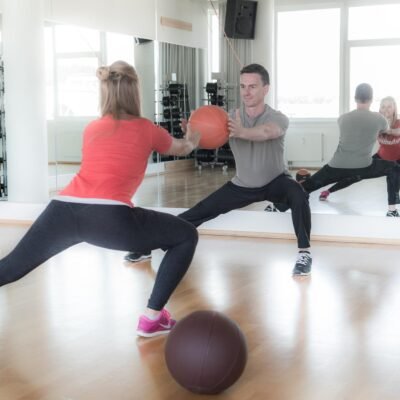Just as the strength of a skyscraper relies on the depth and resilience of its foundation, your physical performance is built on the core stability you develop.
If you’ve ever wondered why some athletes seem to move with effortless grace, the secret often lies not in their visible muscles, but in the unseen power of their core.
Your journey to unlocking this hidden potential starts with understanding why core stability matters and how it can transform your movement and athletic performance.
Let’s explore the anatomy of the core and assess your strength, introducing exercises that can elevate your physical foundation to new heights.
Why Core Stability Matters
Core stability is crucial because it serves as the foundation for almost every movement your body makes. Whether you’re running, lifting, or even sitting, a strong core keeps you balanced and prevents falls. It’s not just about having a toned abdomen; it’s about enhancing your overall performance and preventing injuries.
You’ll find that once you focus on strengthening your core, you’ll see improvements in other areas of your fitness. You’ll lift heavier, run faster, and move more efficiently. It’s the key to unlocking your full athletic potential. Plus, a stable core supports your spine, reducing the risk of back pain, which can sideline your fitness goals.
Anatomy of the Core
Understanding the anatomy of your core is crucial for maximizing the benefits of your stability exercises.
Your core isn’t just about your abs; it’s a complex system that includes muscles in your lower back, hips, pelvis, and abdomen.
These muscles work in harmony to support your spine and pelvis during movement and stability.
The major muscles include the rectus abdominis, often referred to as the ‘six-pack’ muscles, the deeper transversus abdominis, the obliques at your sides, and the multifidus and erector spinae along your spine.
Strengthening this interconnected framework enhances your overall strength, improves your posture, and reduces the risk of injury.
It’s the foundation upon which all other movements are built, making it essential for athletes and non-athletes alike.
Assessing Your Core Strength
Before diving into core stability exercises, it’s crucial to assess your core strength to tailor your workout effectively. Start by observing your posture in a mirror. A slouch or tilt indicates core weakness.
Next, try the plank test. Hold a plank position and note the time before your form breaks—this measures endurance and stability. If you struggle to maintain it for at least 30 seconds, it’s a sign to focus on strengthening.
Additionally, perform a sit-up test. Count how many sit-ups you can do in one minute. Fewer than 15 suggests room for improvement.
Top Core Stability Exercises
Having assessed your core strength, let’s explore the top core stability exercises that can enhance your performance.
First, the plank is a fundamental exercise that targets your entire core. Start on your elbows and toes, keeping your body in a straight line from head to heels. Hold this position, focusing on tightening your abdominal muscles.
Next, try the dead bug. Lie on your back with your arms extended towards the ceiling and your legs raised and bent at 90 degrees. Slowly lower the opposite arm and leg towards the floor, then return to the starting position. This exercise challenges your core stability as you move your limbs.
Lastly, incorporate the Russian twist into your routine. Sit on the floor, knees bent, feet lifted slightly. Twist your torso from side to side, engaging your obliques. These exercises, performed regularly, will significantly improve your core stability.
Enhancing Performance With Stability
Strengthening your core stability can significantly enhance your overall performance in various physical activities. When your core muscles are strong, they support your spine, improving your balance and stability. This means you’re less likely to suffer injuries during physical exertion.
Moreover, a stable core allows for more efficient movements, maximizing the power and precision of your actions. Whether you’re running, jumping, or lifting, a robust core serves as the foundation for all these movements.
By focusing on core stability exercises, you’re not only boosting your athletic performance but also enhancing your day-to-day activities. Improved posture, reduced back pain, and increased endurance are just a few of the additional benefits you’ll experience.
Frequently Asked Questions
Can Core Stability Exercises Help Alleviate Lower Back Pain?
Yes, core stability exercises can help alleviate lower back pain by strengthening the muscles that support your spine.
This can improve your posture and reduce strain on your back, leading to less discomfort.
How Do Core Stability Exercises Impact Posture and Spinal Alignment?
Core stability exercises significantly improve your posture and spinal alignment by strengthening the muscles around your spine.
You’ll stand taller and reduce your risk of back pain, enhancing overall movement and performance.
Are There Specific Core Stability Exercises That Can Benefit Pregnant Women?
Yes, you’ll find specific core stability exercises that are great for pregnant women. They help maintain posture, reduce back pain, and prepare the body for childbirth.
Always consult your doctor before starting any new exercise regimen.
Can Improving Core Stability Reduce the Risk of Sports Injuries?
Yes, improving core stability can significantly reduce your risk of sports injuries.
It enhances your balance and body control, making you less prone to falls and strains during physical activities or sports.
How Does Age Affect One’s Ability to Perform Core Stability Exercises, and Are There Modifications for Older Adults?
As you age, your ability to perform core stability exercises may decrease, but there are modifications to help.
Older adults can adjust intensity and use supportive equipment to maintain safety and effectiveness in their workouts.
Strengthening your core isn’t just about getting a toned belly; it’s the foundation for enhancing your overall performance in any activity. By understanding your core’s anatomy and assessing its strength, you can tailor exercises to your needs.
Incorporate top core stability exercises into your routine to see significant improvements. Remember, a strong core supports better posture, reduces injury risk, and boosts your athletic capabilities. So, don’t underestimate the power of a solid core; it’s your key to unlocking greater performance.





